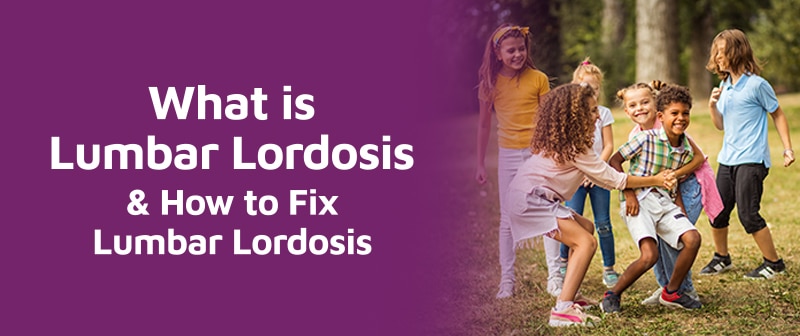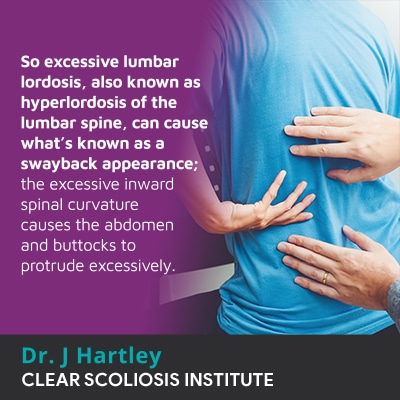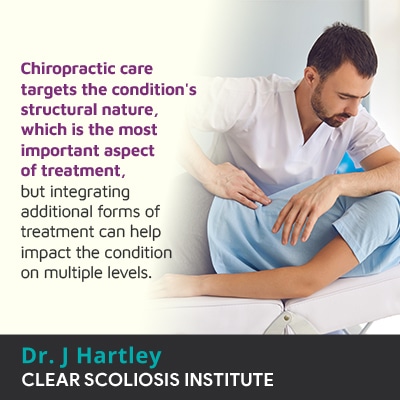
The spine’s natural and healthy curves are key to preserving optimal spinal health, strength, and function. If the spine loses one of its healthy curves, the biomechanics of the entire spine are disrupted as the health of each spinal curve is affected by the condition on the other spinal curves.
Lumbar refers to the lower back, and lordosis refers to a spinal curve that bends inwards, making a standard ‘C’ shape. There is a healthy range of lumbar lordosis, but if it becomes excessive and falls beyond a normal range, this is problematic and can cause a swayback appearance.
Before specifically defining and addressing how to fix a loss of lumbar lordosis, let’s first touch on some basic spinal anatomy for a better understanding of why healthy spinal curves are so important to maintain.
The spine’s natural curves make it appear straight when observed from the front and/or back, and give it an ‘S’ shape when viewed from the left and/or right side.
The spine’s natural curves are important because it has to be strong, flexible, and promote the even distribution of mechanical stress incurred during movement and activity, and the spine’s healthy curves facilitate those functions.
The spine consists of vertebrae (bones) that when aligned, are stacked on top of one another in a straight alignment, but when an unnatural spinal curve develops, some vertebral bodies have shifted their position, either becoming excessively tilted or excessively straight.
The vertebrae are separated by intervertebral discs, and these discs are key spinal structures that are commonly the first to feel the effects of deterioration, and this is important because the discs give the spine structure, act as cushions between adjacent vertebrae, make the spine more flexible, and also act as the spine's shock absorbers.
So going back to how the spine’s natural curves help the spine function, and considering the roles of the spinal discs, it’s clear that the discs are a key part of the spine’s ability to maintain its natural curves and alignment.
In fact, disc degeneration can be the cause of a number of spinal issues/conditions, including lumbar lordosis.
When the spine is aligned, the body’s center of gravity is in place, and a healthy gait can be maintained; an unhealthy gait is an uneconomical one, meaning it takes extra energy to maintain, and this happens if there is a shift in the body’s center of gravity.
If the spine’s natural curves are in place, so too is the body’s center of gravity, but if an unnatural spinal curve develops, there is a shift, and that shift introduces uneven forces and demands the expenditure of more energy to maintain proper posture and an economical gait.
If the lower back loses its healthy range of lumbar lordosis, becoming excessive, the curve of the lower back becomes over-pronounced.

Two spinal-curvature types are kyphosis and lordosis, and kyphosis is found in the thoracic spine, and lordotic curves are found in the cervical and lumbar spinal sections.
So the thoracic spine bends outwards, while the spine bends inwards at the cervical and lumbar sections; the size of these curves can vary significantly from person to person, but if a person’s degree of kyphosis or lordosis falls beyond a normal range, the curvature-size becomes problematic.
A healthy range of cervical lordosis would fall between 20 and 40 degrees, and a healthy range of lumbar lordosis falls between 40 and 60 degrees.
The cervical spine’s lordosis is important because the neck connects the brain to the rest of the body, and the cervical spine also has to support the weight of the head, but excessive lordosis more commonly affects the lumbar spine.
It’s generally accepted that everyone will experience lower back pain/issues at some point in their lives, and this is because the lumbar spine not only has to support the weight of the spinal sections above, and the trunk, it also feels the effects of bending, lifting, and twisting motions.
So excessive lumbar lordosis, also known as hyperlordosis of the lumbar spine, can cause what’s known as a swayback appearance; the excessive inward spinal curvature causes the abdomen and buttocks to protrude excessively.
Again, there is a wide range of lordotic curve sizes, and a person’s lumbar lordosis can become excessive as hyperlordosis, while others can experience a loss of lumbar lordosis, known as flatback syndrome.
As a CLEAR-certified scoliosis chiropractor, I’ve treated a number of spinal conditions including hyperlordosis of the lumbar spine, and the goal of treatment is to restore as much of the spine’s healthy curves as possible.
Once I determine the underlying cause of a patient’s excessive lumbar lordosis, I can customize a treatment plan accordingly based on type, severity, and experienced symptoms.
While some patients don’t experience many noticeable symptoms, others will find the postural changes overt, and in addition to a swayback appearance, excessive lumbar lordosis can also cause:
When an unnatural spinal curve develops, it doesn’t just affect the spine, but also its surrounding muscles and nerves, which is why muscle pain, weakness, and tingling sensations can be common due to compression.

Through a number of chiropractic techniques, including manual adjustments, I attempt to adjust the position of the curve’s most-tilted vertebrae, and when successful, I can realign them with the rest of the spine, restoring a healthy degree of lumbar lordosis.
Chiropractic care targets the condition's structural nature, which is the most important aspect of treatment, but integrating additional forms of treatment can help impact the condition on multiple levels.
Once I start to see structural results as the excessive curvature size is reduced back to a healthy range, I can concentrate on increasing patients’ core strength through physical therapy, and this is important for providing the spine with optimal support from its surrounding muscles, addressing any related muscle imbalance, and improving posture.
Rehabilitation involves a number of custom-prescribed condition-specific exercises and stretches that can help to further stabilize and heal the spine from home.
Lumbar lordosis refers to the lower back’s inward spinal curvature, and if that curvature size becomes excessive, it can cause hyperlordosis of the lumbar spine and is also referred to as swayback: referencing the postural change it causes involving the buttocks and abdomen protruding excessively.
Excessive lumbar lordosis can have a number of causes from chronic poor posture and obesity to intervertebral disc issues and/or the presence of an additional spinal condition, and once its underlying cause is determined, I can craft a treatment plan accordingly.
When an unnatural spinal curve develops, it affects the health of the other spinal curves and can disrupt the entire spine’s biomechanics, and unnatural spinal curves don’t just affect the spine, but also its surrounding muscles, nerves, and the entire body as its center of gravity is shifted.
Lumbar lordosis can mean the lower back’s lordosis has become excessive, but can also refer to a loss of lumbar lordosis, known as flatback syndrome, because the spine becomes excessively straight, causing a different type of postural effect.
When a person’s lumbar lordosis becomes excessive, the lumbar spine needs to have a healthy range of lordosis restored, and this is worked towards through chiropractic care that can impact the condition on a structural level.
Physical therapy is another important facet of treatment as the spine’s surrounding muscles need to be strong to support the spine properly, taking pressure off it and its individual structures, and this can also help with any related muscle imbalances and postural remodeling.
Condition-specific exercises can also help to strengthen the spine and its surrounding muscles, as well as keeping the spine and surrounding muscles flexible.
So when it comes to how to fix lumbar lordosis, each case is unique, but chiropractic care, physical therapy, a variety of additional therapies, and lifestyle guidance are common facets of treatment that can help restore as much of the spine’s natural curves as possible by realigning the spine, which also restores the body’s center of gravity.

CLEAR provides a unique and innovative way of understanding scoliosis. Sign up to receive facts and information you won’t find anywhere else.
